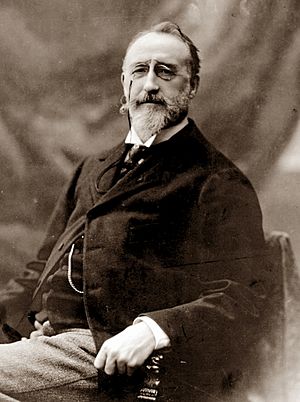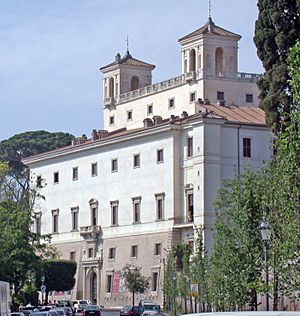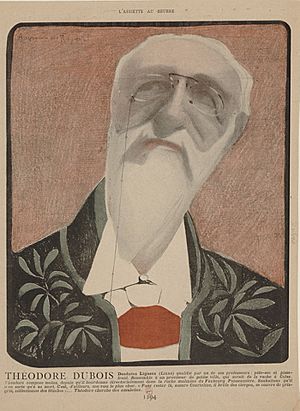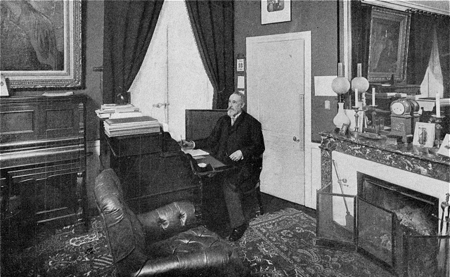Théodore Dubois facts for kids

Clément François Théodore Dubois (born August 24, 1837 – died June 11, 1924) was a French composer, organist, and music teacher. He lived during the Romantic period in music.
After studying at the famous Paris Conservatoire, Dubois won France's top music award, the Prix de Rome, in 1861. He became an organist and choirmaster at well-known churches in Paris. At the same time, he taught at the Conservatoire, first teaching harmony from 1871 to 1891, and then composition from 1891 to 1896. In 1896, he became the director of the Conservatoire, taking over from Ambroise Thomas. He kept the school's very traditional teaching style. He had to retire early after a problem happened with the Prix de Rome competition. It seemed the teachers tried to stop the modern composer Maurice Ravel from winning.
As a composer, Dubois was seen as skilled and tasteful. However, people didn't think his music was very new or exciting. He hoped to write many operas, but he became more famous for his church music. His books about music theory were important and were used for many years.
Contents
Life and Career
Early Life and Studies
Dubois was born in Rosnay, a small village near Reims in France. His family was not involved in music. His father, Nicolas, made baskets, and his grandfather was a schoolteacher. His mother, Célinie Dubois, stayed home to raise young Théodore.
Dubois started learning piano from Louis Fanart, who was the choirmaster at Reims Cathedral. A local mayor, Vicomte Eugène de Breuil, helped him meet the pianist Jean-Henri Ravina. Thanks to Ravina, Dubois was accepted into the Paris Conservatoire in 1854. The Conservatoire was led by Daniel Auber at the time.
At the Conservatoire, Dubois studied piano with Antoine François Marmontel and organ with François Benoist. He learned harmony from François Bazin and counterpoint and composition from Ambroise Thomas. While still a student, he played the organ at churches like St Louis-des-Invalides (starting in 1855) and Sainte-Clotilde (starting in 1858, under the famous César Franck). He won first prizes for harmony, fugue, and organ. Finally, in 1861, he won France's top music award, the Prix de Rome.
Time in Rome
Winning the Prix de Rome meant Dubois could live and study for free at the French Academy in Rome. This academy was located at the beautiful Villa de Medici. He arrived in December 1861 and became friends with other students, including Jules Massenet, who would also become a famous composer.
While studying, Dubois explored the old buildings of Rome and the countryside around it. He went to musical performances at the Sistine Chapel. He also took trips to other Italian cities like Naples, Pompeii, Venice, Verona, Mantua, Milan, and Florence. He put his experiences into music, writing an overture, a funny Italian opera called La prova di opera seria, and a serious Mass. He even met the famous composer Franz Liszt in Rome, who heard his Mass and encouraged him.
Return to Paris and Career Growth
When Dubois returned to Paris in 1866, he became the choirmaster at Sainte-Clotilde. In 1867, his work Les Sept paroles du Christ (The Seven Last Words of Christ) was performed there. It was later performed at other concerts and churches.

In 1871, Camille Saint-Saëns and Romain Bussine started the Société nationale de musique (National Music Society). Dubois was one of the first members, along with other important composers like Henri Duparc, Gabriel Fauré, César Franck, and Massenet. In the same year, he became choirmaster at the Church of the Madeleine. During the Franco-Prussian War (1870–71), he joined the National Guard. His friend and biographer, Hugues Imbert, wrote that Dubois and Saint-Saëns often met at the Madeleine church in their military uniforms, one to lead the choir and the other to play the organ. Both men left Paris during the violent end of the Paris Commune. Saint-Saëns went to England, and Dubois went back to his family home in Rosnay.
Dubois joined the teaching staff of the Conservatoire in 1871. He became a professor of harmony and taught there for 20 years. Some of his students, who later became famous composers, included Paul Dukas, George Enescu, Albéric Magnard, and Florent Schmitt. In August 1872, Dubois married the pianist Jeanne Duvinage. Her father was a conductor at the Opéra-Comique. They had a happy marriage and two children.
Dubois really wanted to compose operas, but he found it hard to get his works performed at the big opera houses in Paris. His one-act opera La Guzla de l'Emir was performed successfully in 1873. In 1878, he won a prize from the city of Paris for his oratorio Paradis perdu (Paradise Lost). This work was performed several times at the Théâtre du Châtelet.
In 1877, Dubois took over from Saint-Saëns as the organist at the Madeleine church. Gabriel Fauré then became the choirmaster. In 1879, one of Dubois's operas, Le Pain bis, was performed at the Opéra Comique. Critics thought the music was clever and elegant, with good melodies. In 1880, Dubois and Fauré traveled to Munich to see operas by Richard Wagner. Although they were impressed, Dubois did not let Wagner's style change his own music much.
Dubois never had an opera performed at France's top opera house, the Paris Opéra. However, in 1883, his three-act ballet La Farandole was performed there. Critics said the music was "distinguished" and well-suited to the story. This ballet was very popular and was performed many times. In the same year, Dubois received the Legion of Honour, a high award in France.
In 1884, Dubois had a successful but expensive opera called Aben-Hamet. It was well-received, but the theater closed after only four performances due to money problems. This left Dubois responsible for paying the singers.
Later Years and Conservatoire Leadership
When the composer Léo Delibes died in 1891, Dubois was chosen to take his place as a professor of composition at the Conservatoire. After Charles Gounod died in 1894, Dubois was elected to the Académie des Beaux-Arts. This showed that people recognized the "clear and ideal" quality of his music.
In 1896, Ambroise Thomas, the director of the Conservatoire since 1871, passed away. Many expected Jules Massenet to become the new director. However, Massenet insisted on being appointed for life, and when the French government refused, he resigned. Dubois was then appointed director. He continued Thomas's very traditional approach to teaching. Music by composers like Auber, Halévy, and especially Meyerbeer was considered the right style for students. Older French music by Rameau and modern music, including Wagner's, were kept out of the lessons.
Dubois strongly disliked Maurice Ravel, a Conservatoire student who did not follow the school's anti-modern rules. In 1902, Dubois even tried to stop Conservatoire students from going to see Debussy's new and groundbreaking opera, Pelléas et Mélisande.
In June 1905, Dubois had to retire earlier than planned. This was because of a public scandal. The teachers at the Conservatoire clearly tried to stop Ravel from winning the Prix de Rome. Gabriel Fauré was chosen to replace Dubois as director, with the task of making the school more modern.
In his personal life, Dubois was not as traditional as he was as a school director. When Wagner's Parsifal was finally performed in Paris in 1914, Dubois told a friend that no music more beautiful had ever been written. He was also privately interested in Debussy's music, calling its harmonies "subtle" and "precious."
After retiring from the Conservatoire, Dubois remained a well-known person in Parisian music circles. He was president of the association for former Conservatoire students. He stayed active until his final years. His wife's death in 1923 greatly affected him, and he passed away at his Paris home on June 11, 1924, at the age of 86.
Music
Even though he wrote many religious pieces, Dubois really hoped to have a successful career writing operas. His interest in stories from the Near East led him to compose his first staged work, La guzla de l'émir, and his first four-act opera, Aben-Hamet. The latter received great reviews, but it did not become a regular part of the opera repertoire. His other large opera, Xavière, is set in the countryside of Auvergne. It tells the story of a widowed mother who tries to kill her daughter, Xavière, to get her inheritance. Xavière survives, and the opera ends happily.
Dubois's music also includes ballets, oratorios (large musical works for choir and orchestra, usually on a religious theme), and three symphonies. His most famous work is the oratorio Les sept paroles du Christ ("The Seven Last Words of Christ"), written in 1867. This piece is still performed sometimes today. His Toccata in G (1889) is still a popular piece for organists. Most of his other many works are not often performed anymore. However, he had a lasting impact through his teaching. His books on music theory, such as Traité de contrepoint et de fugue (about counterpoint and fugue) and Traité d'harmonie théorique et pratique (about harmony), are still sometimes used today.
Selected Works
Operas
- La prova di un'opera seria, (not published, composed in Rome, 1863).
- La guzla de l'émir, comic opera (1 act, J. Barbier & M. Carré), first performed April 30, 1873, Théâtre de l'Athénée, Paris.
- Le pain bis, comic opera (1 act, A. Brunswick & A.R. de Beauplan), first performed February 26/27, 1879, Opéra-Comique (Théâtre Favart), Paris.
- L'enlèvement de Proserpine, lyric scene (1 act, P. Collin), first performed 1879.
- Aben-Hamet, opera (4 acts, L. Détroyat & A. de Lauzières), first performed December 16, 1884, Théâtre du Châtelet, Paris.
- Xavière, dramatic idyll (3 acts, L. Gallet, after F. Fabre), first performed November 26, 1895, Opéra Comique (Théâtre Lyrique), Paris.
- Miguela, opera (3 acts) (Originally not performed, except prelude and a scene from Act 3, concert performance February 23, 1896, Paris.) first performed May 18, 1916, Opéra, Paris.
- La fiancée d'Abydos (not performed)
- Le florentin (not performed)
Ballets
- La Korrigane, (ballet by Louis Mérante), first performed January 12, 1880, Opéra, Paris.
- La Farandole, (ballet by Louis Mérante), first performed December 14, 1883, Opéra-Comique, Paris.
Vocal Works
- Les Sept Paroles du Christ, (1867) oratorio dedicated to Abbot Jean-Gaspard.
- Le Paradis Perdu, oratorio (1878 - Prize from the city of Paris)
- Many cantatas (vocal works with instrumental accompaniment), including: L'enlèvement de Proserpine, Hylas, Bergerette; Les Vivants et les Morts.
- Masses and other religious compositions.
Orchestral Works
- Marche héroïque de Jeanne d'Arc (Heroic March of Joan of Arc)
- Fantaisie triomphale for organ & orchestra
- Hymne nuptial (Wedding Hymn)
- Méditation, Prières for strings, oboe, harp, & organ
- Concerto-Capriccio for piano & orchestra, C minor (1976)
- Concerto pour piano n° 2, F minor (1897)
- Concerto pour violon (Violin Concerto)
- Notre-Dame de la Mer, symphonic poem
- Adomis, symphonic poem
- Symphonie française (French Symphony) (1908)
- Symphonie n°2
- Symphonie n°3
- Fantasietta (1917)
- Suite for Piano and String Orchestra in F minor (1917)
Chamber Music
- Cantabile (or Andante Cantabile) for viola or cello and piano (1886)
- Hymne nuptial for violin, viola, cello, harp and organ
- Quintet for oboe, violin, viola, cello and piano
- Terzettino for flute, viola and harp (1905)
- Piano Quartet in A minor (1907)
- Dectet for string and wind quintets
- Nonetto for flute, oboe, clarinet, bassoon, 2 violins, viola, cello and double bass
- Nocturne for cello and piano
Other Compositions
- Piano works: Chœur et Danse des Lutins (Choir and Dance of the Goblins), Six Poèmes Sylvestres (Six Forest Poems), etc.
- Many pieces for organ and for harmonium.
- Douze Pièces pour orgue ou piano-pédalier (Twelve Pieces for organ or pedal piano) (1889), including the famous Toccata in G (no. 3)
- Douze Pièces Nouvelles pour orgue ou piano-pédalier (Twelve New Pieces for organ or pedal piano) (1893), including In Paradisum (no. 9)
- Deux Petites Pièces pour orgue ou harmonium (Two Small Pieces for organ or harmonium) (1910): Petite pastorale champenoise et Prélude
- 42 Pièces pour orgue sans pédales ou harmonium (42 Pieces for organ without pedals or harmonium) (1925)
Writings
- Dubois, Théodore (1889). Notes et études d'harmonie pour servir de supplément au traité de H. Reber. Paris: Heugel.
- Dubois, Théodore (1901). Traité de contrepoint et de fugue. Paris: Heugel.
- Dubois, Théodore (1921). Traité d'harmonie théorique et pratique. Paris: Heugel.
- Dubois, Théodore (1921). Réalisations des basses et chants du Traité d'harmonie par Théodore Dubois. Paris: Heugel.
Recording Selection
- Théodore Dubois, Organistes de Paris à la Belle Époque, Vol 1 (2004), Helga Schauerte-Maubouet, Organ Merklin Cathedral in Moulins(F) Syrius 141382.
- Theodore Dubois, The Romantic Piano Concerto #60, (2013) Concerto-capriccioso in C minor; Piano Concerto #2 and Suite for Piano and String Orchestra, Cédric Tiberghien (pianist), BBC Scottish Symphony Orchestra, Andrew Manze-conductor, Hyperion 67931
- Théodore Dubois, Musique sacrée et symphonique & Musique de Chambre (2015), Various performers; BruZane ES1018RSK (Volume 2 in Collection Portraits)
See also
 In Spanish: Théodore Dubois para niños See: List of music students by teacher: C to F#Théodore Dubois.
In Spanish: Théodore Dubois para niños See: List of music students by teacher: C to F#Théodore Dubois.




